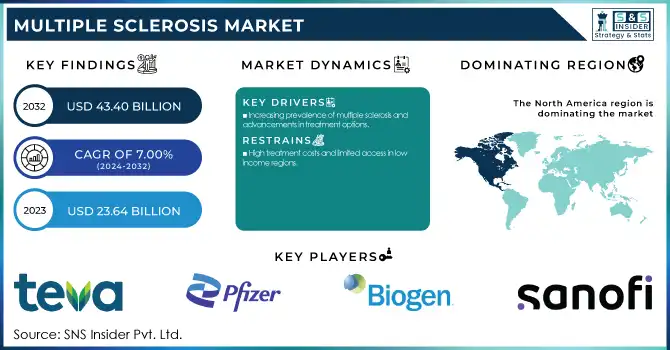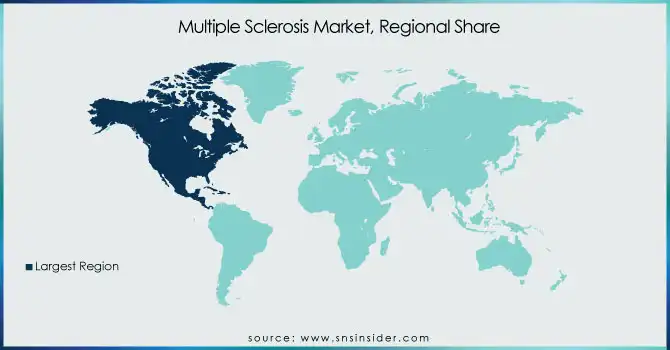Multiple Sclerosis Market Size & Trends:
The Multiple Sclerosis Market size was valued at USD 23.64 billion in 2023 and is projected to reach USD 43.40 billion by 2032 and grow at a CAGR of 7.00% over the forecast period of 2024-2032.
This report shows the rising incidence and prevalence of MS, as well as different prescription trends across regions, which are influenced by the changing treatment landscape. The study also looks into healthcare spending on MS treatments, including government, commercial, private, and out-of-pocket expenditures by region. It analyzes current market trends in MS research and drug development, highlighting innovations in therapeutic approaches. The report also elaborates on patient demographics, highlighting the influence of age, gender, and regional factors on disease progression and treatment adherence trends, thus providing a comprehensive view of the market's dynamics.

Get More Information on Multiple Sclerosis Market - Request Free Sample Report
Multiple Sclerosis Market Dynamics
Drivers
-
Increasing prevalence of multiple sclerosis and advancements in treatment options.
One of the primary growth drivers for the MS treatment market is the increasing incidence of multiple sclerosis (MS) globally. With the aging population and greater awareness of the disorder, the need for proper therapeutic management has also increased. Moreover, innovations in drug formulation are further enhancing market growth through the development of newer therapies, such as oral and injectable treatments. The development of targeted therapies such as ocrelizumab (Ocrevus) and the availability of biologics are enhancing treatment outcomes, driving demand from both healthcare providers and patients. Increased investment in research and development by pharmaceutical companies is also a key driver, aiming to address the unmet needs in MS management and improve patient quality of life. With increased awareness of MS as a major health challenge, the government is showing greater support, thus boosting the market growth.
Restraints
-
High treatment costs and limited access in low-income regions.
A primary limitation of MS therapies is that they are relatively expensive, particularly biologics, making access difficult for many patients, especially in poorer parts of the world. Cost can be a big barrier for patients with long-term treatment for many people, particularly in the undeveloped world. Another issue is the side effects and complexities of certain drugs, which could discourage a patient from taking their prescribed treatments. Further regulatory issues and delays in the approval of new treatments also challenge the companies to launch innovative therapies across the globe. It may hold back overall market growth.
Opportunities
-
Expanding market in emerging economies and advancements in personalized medicine.
The MS treatment market offers several opportunities, especially in emerging economies where the healthcare infrastructure is rapidly improving. As countries like India, China, and Brazil continue to enhance their healthcare systems, the demand for MS treatments is expected to rise significantly. Moreover, the development of personalized medicine tailored to individual genetic profiles offers significant potential. Tailored treatments will have more effectiveness and fewer side effects, and thus can lead to increased adherence and patient satisfaction. This new trend toward precision medicine can become a promising avenue for the pharmaceutical industry in expanding its products and entering new markets.
Challenges
-
Drug Side Effects, Complexity of Diagnosis, and Treatment Adherence.
Some of the major challenges in the MS treatment market are side effects that accompany most MS drugs, especially biologics, which lead to adverse reactions and poor patient adherence to the prescribed treatment regimen. The complexity of diagnosing MS, whose symptoms often overlap with other neurological disorders, may also delay treatment and hinder timely intervention. In addition, though new treatments have significantly improved the prognosis of many patients, treatment compliance is still a major challenge, as some therapies require frequent monitoring, injections, or infusions. These issues can complicate the management of MS, affecting long-term treatment success and overall market growth.
Multiple Sclerosis Market Segmentation Insights
By Drug Class
In 2023, the immunosuppressants segment held the largest market share of 63.9%. This can be attributed to the widespread use of immunosuppressive drugs in various medical conditions such as autoimmune diseases, organ transplantations, and cancer treatments. These drugs play a crucial role in preventing organ rejection and managing conditions that involve excessive immune response, thus leading to their high market share. Owing to the continued rising prevalence of such health disorders, the market for immunosuppressants is likely to be dominated once again by its immunosuppressants segment.
The immunostimulants segment is expected to grow the fastest throughout the forecast period. Growing demand for boosting immunity in the body in cases where immunity is weakened, along with increasing awareness of their role in not only preventing infections but also their overall well-being, is directly helping in this growth. Second, growing interest in preventive healthcare and new therapy related to immunostimulation will help drive the growth of this segment.
By Route of Administration
The injectable segment dominated the route of administration category in 2023 with a share of 54.5%. This is mainly because injectables provide a more direct and faster method of delivering medications as compared to oral forms. In particular, patients requiring immediate relief are favored with the drug administered through an injectable. The injectables also find their major use through drugs that cannot be taken orally. This method also gives more accurate dosing and high bioavailability of some drugs. This makes it the first choice in many therapeutic areas.
The oral administration segment will grow the fastest rate. This will be driven by the convenience, ease of use, and cost-effectiveness offered by oral medications, making them very attractive for long-term treatments. Increased biologics and complex molecules' formulations are further being developed for oral usage, further creating a growth prospect in this segment.
By Distribution Channel
The hospital pharmacies segment led the distribution channel category in 2023, with a share of 47.5%. Hospital pharmacies are one of the biggest shares of pharmaceutical sales, as most treatments are administered in hospitals and clinics to patients suffering from acute or complex conditions. Hospital pharmacies also handle the distribution of specialty drugs, such as injectables and immunosuppressants, which are prescribed more frequently in clinical settings. The trust and convenience associated with hospital pharmacies make them the most preferred in the market.
The retail pharmacies segment will also be expected to grow at the fastest pace of all distribution channels. Such growth is also triggered by growing numbers of people turning to over-the-counter medication, as well as the extension of retail pharmacies and their more significant offerings in the pharmaceutical segment. In addition, the rapid spread of electronic prescriptions and more affordable healthcare services for chronic illnesses is likely to help the retail pharmacy segment soar even higher.
Multiple Sclerosis Market Regional Analysis
In 2023, North America dominated the market, mainly attributed to its more advanced healthcare infrastructure, high rate of adoption of innovative therapies, and the continuously increasing prevalence of chronic diseases, which require the treatment of treatments such as immunosuppressants and injectable medications. The presence of major pharmaceutical companies and robust healthcare policies has further contributed to the region's market leadership.
Europe closely followed, as there was a high demand for immunosuppressive and immunostimulatory drugs in countries having aging populations such as Germany and the UK. The health systems in Europe have been evolving; hence, people are accessing highly advanced treatments more than ever before.
The Asia-Pacific region is expected to be the fastest-growing region throughout the forecast period, with growing healthcare expenditure, improvement in health infrastructure, and enormous and swelling populations. Prescription demand is rising steeply in countries such as China and India injectable as well as oral drugs, driven by increased awareness about healthcare and healthcare amenities. This region also witnesses a spree in the sale of pharmaceutical products through e-commerce sites.

Need any customization research on Multiple Sclerosis Market - Enquiry Now
Multiple Sclerosis Market Key Players
-
Teva Pharmaceutical Industries Ltd. - Copaxone, Austedo
-
Pfizer Inc. - Braftovi, Mylotarg
-
Biogen - Tecfidera, Avonex, Tysabri
-
Bayer AG - Betaseron, Cladribine
-
Sanofi - Aubagio, Lemtrada
-
F. Hoffmann-La Roche Ltd. - Ocrevus, Rituxan
-
Johnson & Johnson Services, Inc. - Gilenya
-
Merck & Co., Inc. - Rebif, Mavenclad
-
Takeda Pharmaceutical Company Limited - Entyvio
-
Horizon Therapeutics plc - Krystexxa
Recent Developments:
-
In Nov 2024, the National Multiple Sclerosis Society has awarded USD 1 million to researchers at Case Western Reserve University to explore a new approach for treating Multiple Sclerosis. This funding highlights ongoing efforts to advance treatment options and enhance the understanding of the disease.
-
In July 2024, the Medicines and Healthcare Products Regulatory Agency approved a new formulation of ocrelizumab (Ocrevus 920mg solution for injection) for the treatment of relapsing forms of multiple sclerosis and primary progressive multiple sclerosis in adults. This approval marks a significant development in the treatment options for multiple sclerosis.
| Report Attributes | Details |
|---|---|
|
Market Size in 2023 |
USD 23.64 billion |
|
Market Size by 2032 |
USD 43.40 billion |
|
CAGR |
CAGR of 7% From 2024 to 2032 |
|
Base Year |
2023 |
|
Forecast Period |
2024-2032 |
|
Historical Data |
2020-2022 |
|
Report Scope & Coverage |
Market Size, Segments Analysis, Competitive Landscape, Regional Analysis, DROC & SWOT Analysis, Forecast Outlook |
|
Key Segments |
• By Drug Class [Immunosuppressants, Immunostimulants] |
|
Regional Analysis/Coverage |
North America (US, Canada, Mexico), Europe (Eastern Europe [Poland, Romania, Hungary, Turkey, Rest of Eastern Europe] Western Europe] Germany, France, UK, Italy, Spain, Netherlands, Switzerland, Austria, Rest of Western Europe]), Asia Pacific (China, India, Japan, South Korea, Vietnam, Singapore, Australia, Rest of Asia Pacific), Middle East & Africa (Middle East [UAE, Egypt, Saudi Arabia, Qatar, Rest of Middle East], Africa [Nigeria, South Africa, Rest of Africa], Latin America (Brazil, Argentina, Colombia, Rest of Latin America) |
|
Company Profiles |
Teva Pharmaceutical Industries Ltd., Pfizer Inc., Biogen, Bayer AG, Sanofi, F. Hoffmann-La Roche Ltd., Johnson & Johnson Services, Inc., Merck & Co., Inc., Takeda Pharmaceutical Company Limited, Horizon Therapeutics plc. |

